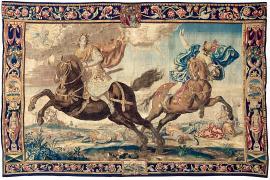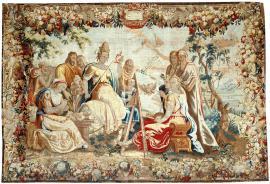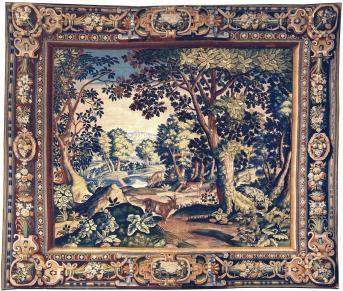Baroque
In the early years of the 17th century there was a further design revolution, which mirrored stylistic changes in painting. The most influential artist was doubtless Peter Paul Rubens (1577-1640) in laying the groundwork of the Baroque. Rubens also personally designed several major tapestry series, including Decius Mus (c1616), The Story of Constantine (1622), The Triumph of the Eucharist (c1625), and The Story of Achilles (c1630). His designs helped to change taste and influenced succeeding tapestry designers, including Jacob Jordaens (1593-1678), Cornelis Schut (1697-1655), Simon Vouet (1590-1649), Pietro da Cortona (1596-1669) and even Charles Le Brun (1619-1690) half a century later. Baroque designs are characterised by over-scale, almost inflated, figures and dramatic compositions, which emphasise theatricality over intricate detail. At the same time a large market was evolving for landscapes and park scenes, frequently framed by Baroque style borders.
Landscape Tapestry with Goat
Price on application
France, circa 1660
Probably Woven by Hippolyte de Comans
12ft 5in width x 10ft 8in height
3.78m x 3.25m
-

The Stapleford Park Tapestry
Price on application
The Destruction of Niobe's Children
A Highly Important Lambeth Tapestry
From the series The Great Horses
After designs by Francis Cleyn (1582-1658)
With the Arms of Edward Brabazon,
Second Earl of Meath
England, circa 1665
17ft 5in width x 11ft 5in height
5.31m x 3.48m
Provenance: Stapleford Park -

Liberal Arts: Painting and Sculpture
Price on application
Woven in the workshops of Jan Leyniers (signed)
Brussels, 18th Century
18ft 5in width x 12ft 8in height
6.61m x 3.86m
